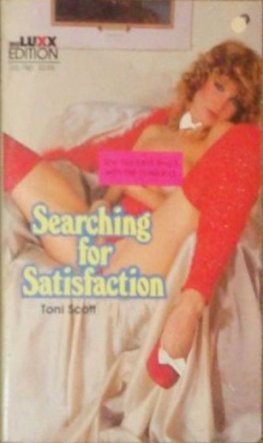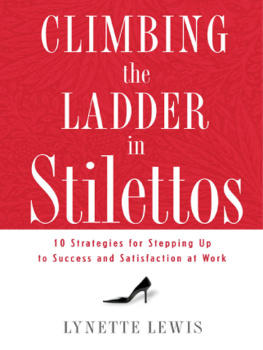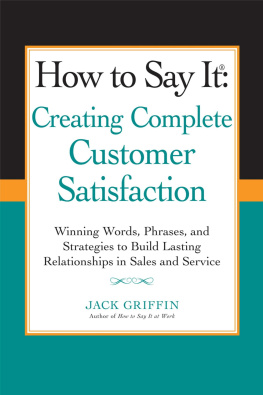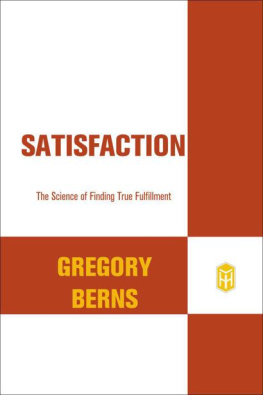Recycle all those other self-help booksthis is the only one you will need. The secret to a true, deep happiness can be found in these beautifully personal stories from ordinary Americans. I was genuinely inspired after reading this book. Get Satisfied: How Twenty People Like You Found the Satisfaction of Enough will help you find joy in a place that you might have forgotten to look: your own life.
ALEXANDRA PAUL
Actor and Activist
Get Satisfied: How Twenty People Like You Found the Satisfaction of Enough heralds a satisfaction movement in this country, and not a moment too soon. Judging from the flood of public responses to the call for satisfying stories, people want fulfillment and sufficiency. What a relief for our maxed-out lives and for our maxed-out planet! Everybody finds the satisfaction of enough in different ways and this book shines a light forward on many of them. Im glad Im satisfied. You will be too.
ED BEGLEY, JR.
Actor and Activist
Presents inspiring case studies... The message: If they can do it, so can you. Its about feeling satisfied, not deprived. About filling up, not emptying out.
0, THE OPRAH MAGAZINE
The 20 people whose stories are included in Get Satisfied for the most part live in regular houses in urban or suburban neighborhoods across the country... how they define the concept of enough varies dramatically from one story to the next.
MSN.COM,
LIZ PULLIAM WESTON
HOW
TWENTY PEOPLE
LIKEYouFOUND
THE SATISFACTION
OF ENOUGH
Foreword by PETER C. WHYBROW, M.D.
Edited by CAROL HOLST

Copyright 2007, 2009 Postconsumers
The individual authors whose work appears herein
retain copyright to their respective works.
eBook Edition Published 2011
eBook ISBN 978-1935212-35-5
Print ISBN 978-09743806-8-1
All rights reserved. No portion of this book may be reproduced
in any fashion, print, facsimile, or electronic, or by any method yet to be developed,
without express written permission of the publisher.
Print copies of this book are available at special discounts when purchased in bulk
for premiums and sales promotions, as well as for fund-raising or educational uses.
Special editions or book excerpts can be created to customer specifications.
For details and further information, contact:
Special Sales Director
Easton Studio Press
P.O. Box 3131
Westport, CT 06880
(203) 454-4454
www.eastonsp.com
www.postconsumers.com
Postconsumers
P.O. Box 9955
Glendale, CA 91226
USA
Cover and interior book design by Barbara M. Bachman
Bob Marley quoted lyrics from the song Exodus,
on the album Exodus, Polygram Records, 1977
Open your eyes, look within.
Are you satisfied with the life youre livin?
BOB MARLEY
CONTENTS
J. Eva Nagel 57 STILLWATER, NY
Todra Payne 40 HARRISBURG, PA
Michael Beck 66 GLENDALE, CA
Tamsen Butler 33 PAPILLION, NE
Andrew Vietze 38 APPLETON, ME
Katherine Hauswirth 39 DEEP RIVER, CT
Galen Warden 49 ROCKAWAY, NJ
Brian Simkins 33 CHICAGO, IL
Liz Milner 51 ANNANDALE, VA
Jon Myhre 73 OJAI, CA
Stephanie Barton 34 KAILUA, HI
Fred Ecks 41 SOUTH SAN FRANCISCO, CA
Derek Donald Hambrick 32 DECATUR, GA
Bob Hinschlger 51 ST. MARYS, OH
Teena Hammond Gomez 39 SHELBYVILLE, KY
Ruth Pittard 61 WHIDBEY ISLAND, WA
Beth Herndon 28 MURFREESBORO, TN
Erik Richardson 37 MILWAUKEE, WI
Emily Houston 24 BROOKLYN, NY
Steven Fisher 43 HARTFORD, WI
S TORYTELLING IS AN ANCIENT ART.
Storytelling reflects the patterning of the human mindthe ordering of a random stockpile of personal experience into a meaningful, coherent, and unfolding theme. For each of us, in our journey along lifes pebbled path, it is story that binds the start to the finish. And when stories are shared they can entertain, explain, and teach.
So I was reminded, on a recent visit to London, when I found myself standing in front of William Hogarths A Rakes Progress at the Tate Gallery. Hogarths story of Tom Moneypenny Rakewell is familiar: a young man of good education, finding himself in sudden wealth at the death of his miserly father, turns to spendthrift ways in ardent imitation of the profligate life of the aristocrat.
In the course of eight detailed and engaging tableaus the young Oxford graduate, seduced by luxury fever and exploited by the greed of others, is seen to drift from opulence and material abundance to the debtors prison, ultimately to end his days in the madhouse. Tom, as Hogarth makes clear, is destroyed in his person by what today we might call a nasty case of addictive consumption. In short Tom loses control of his lifes story, as is portrayed in these words of a contemporary writer: Losing a thousand pounds... in a night Tom bets insanely on his horses at Epsom or Newmarket only to loseloselose; but he is in the charmed circle; the mania is workingnothing can hold him back.
William Hogarth, standing a little under five feet in his socks, irreverent, pugnacious, and a snappy dresser, was an inveterate storyteller and a much-loved critic of the political and cultural issues of his time. In fact Hogarth lived in a period of rapid social change not dissimilar to our own. The series of paintings A Harlots Progress and A Rakes Progress, and the engraved prints from those works that made him famous (and rich), were a runaway success in the 1730s, the era of market speculation and emerging global trade most remembered now for the scandal of the South Sea Bubble. The rapid growth of commerce and the pressures of a burgeoning market economy, the rapidly increasing urban population, and a growing freedom of individual expression together with its associated disruption of the familiar social order was, for many, a source of both wonder and anxiety. The turmoil fostered a demand for guidelines and for models of behavior that the writers and artists of the day, in books and magazinesand Hogarth in his social portraiture of cautionary talessought to satisfy.
If this all sounds strangely familiarwith todays self-help books, reality TV shows, and good-life gurus promising the secret to self-discovery and richesit is because in America an addictive mania is once again the contemporary experience. But today there are some important twists. First, never in the history of our species have we experienced such abundanceof material goods, of information, and of choiceas we do now in America and in the developed world. Secondly, no longer are the persons caught up in the acquisitive frenzy numbered in their thousands, as in Hogarths time, but rather in their millions. The craving and blind social striving for stuff and more stuff that drove Tom Rakewell to his ruin is now fostered as Americas preferred route to happiness by a daily blizzard of mind-numbing promotion. In consequence, for many in our society the drive for profit has become a way of life where more will never be enough.
In American culture we increasingly worship the market as an ideology rather than recognizing it for what it isa natural product of human social evolution and a set of valuable tools through which we may shape a healthful and equitable society. Across the globe technology has dramatically changed the checks and balances that regulate the marketplace. Americas traditional immigrant values of resourcefulness, thrift, prudence, and an abiding concern for family and community have been hijacked by a commercially driven, all-consuming self-interest that is rapidly making us sick, both as individuals and as a society.
Next page













